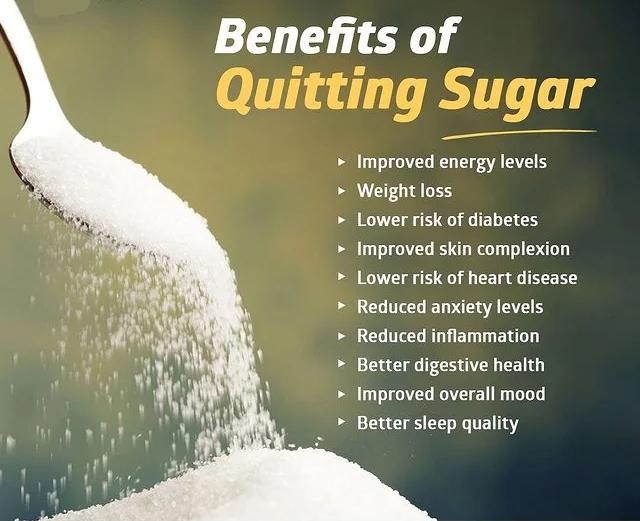In today’s fast-paced world, sugar is everywhere—from your morning cereal to your evening snack. While it may add sweetness, science shows that excess sugar wreaks havoc on our health. But cutting sugar doesn’t mean giving up flavor. This article dives deep into the science of sugar, reveals its hidden sources, and offers practical, delicious ways to reduce your intake. Learn how to satisfy your taste buds while nourishing your body—naturally and healthfully.

Understanding the Role of Sugar
What Is Sugar?
Sugar is a simple carbohydrate found in many foods. It exists naturally in fruits, vegetables, and dairy. However, the problem lies in added sugars. These are refined or processed sugars added to foods to enhance taste and preserve shelf life.
The Types of Sugar
- Glucose: The body’s primary energy source.
- Fructose: Found in fruits and honey.
- Sucrose: Table sugar, a combination of glucose and fructose.
- Lactose: Natural sugar in milk.
Added sugars typically come in the form of high-fructose corn syrup, cane sugar, and other artificial sweeteners.
How Sugar Affects the Body
Sugar provides a quick energy boost. But excess consumption leads to serious health issues. Research links high sugar intake to obesity, diabetes, heart disease, liver problems, and even certain cancers.
When consumed in large amounts, sugar spikes insulin levels. Over time, this can lead to insulin resistance. The pancreas has to work harder, raising the risk of Type 2 diabetes. Moreover, sugar causes inflammation, which damages cells and contributes to chronic diseases.
Why Reducing Sugar Matters
Global Health Recommendations
The World Health Organization recommends limiting added sugar to less than 10% of total daily calorie intake. Ideally, this should be under 5% for added health benefits. For a 2,000-calorie diet, that’s about 25 grams or 6 teaspoons.
Hidden Sources of Sugar
Even when you skip candy or desserts, sugar finds its way into unexpected foods:
- Ketchup
- Salad dressings
- Flavored yogurts
- Granola bars
- Breakfast cereals
These hidden sugars contribute to daily intake without you realizing it. Reading labels becomes essential.
Debunking the Myth: Flavor vs. Sugar
Many believe that sugar equals flavor. This is a myth. Sugar can enhance certain tastes, but it also masks natural flavors. When people reduce sugar, they often notice other flavors more distinctly.
The Science of Taste
Taste buds detect five main flavors:
- Sweet
- Salty
- Sour
- Bitter
- Umami
Sugar primarily affects sweetness, but the perception of flavor is far more complex. Smell, texture, and temperature also play a role. When sugar is reduced, these other elements become more noticeable, enriching the overall experience.
Cutting Sugar Without Sacrificing Taste
Start Gradually
Going cold turkey rarely works. Start by reducing sugar in drinks, such as coffee or tea. Gradually decrease the sugar in baking recipes or switch to unsweetened products.
Use Natural Sweeteners
Natural alternatives can replace sugar without the health risks:
- Stevia: A plant-based sweetener with zero calories.
- Monk Fruit: Sweet but doesn’t raise blood sugar levels.
- Erythritol: A sugar alcohol that doesn’t cause tooth decay.
- Date Paste: Rich in fiber and antioxidants.
These substitutes help maintain sweetness while supporting better health.
Enhance Flavor Through Other Means
Use Herbs and Spices
Vanilla, cinnamon, nutmeg, and cardamom can add complexity to dishes. They provide a sense of warmth and depth.
Add Citrus
Lemon and orange zest brighten both sweet and savory dishes. Their natural oils activate taste receptors and enhance aroma.
Focus on Umami
“For example, ingredients like mushrooms, tomatoes, soy sauce, and nutritional yeast can boost umami flavor. As a result, meals feel more satisfying, reducing the desire for sugar.”
Roast or Caramelize Foods
“In addition, slow cooking or roasting brings out the natural sugars in vegetables like carrots, onions, and sweet potatoes. These methods intensify natural sweetness without needing additives.”
Embrace Texture
Creaminess, crunch, and chewiness contribute significantly to enjoyment. Add nuts, seeds, or yogurt to improve texture and mouthfeel.

Sugar and Brain Chemistry
The Dopamine Connection
Eating sugary foods activates our dopaminergic system , which is responsible for motivation and reward in the brain. This leads to the release of dopamine. When we consume sugar, dopamine levels temporarily increase. The dopamine released reinforces the behaviour that led to that reward, such as eating. Dopamine also influences how hard we try to get a reward.
This cycle can lead to cravings and dependence. Reducing sugar breaks this pattern. Over time, your palate adjusts, and you begin to appreciate less-sweet foods.
Emotional Eating and Sugar
Many people eat sugary foods for comfort. Emotional eating is closely tied to stress, boredom, or anxiety. Identifying triggers helps you break the habit.
Healthy coping mechanisms include:
- Exercise
- Meditation
- Journaling
- Talking to a friend
Scientific Studies Supporting Sugar Reduction
Multiple studies confirm the benefits of reducing sugar:
- A Harvard study found that cutting sugar improves heart health.
- A 2015 study in BMJ linked sugary drinks with an increased risk of Type 2 diabetes.
- A review in Nature highlighted how sugar promotes inflammation and oxidative stress.
Additionally, participants in long-term studies reported improved energy, better sleep, and enhanced mental clarity after cutting sugar.
Reading Labels and Making Smart Choices
How to Spot Hidden Sugar
Food companies use over 60 names for sugar. Common ones include:
- Corn syrup
- Dextrose
- Maltose
- Evaporated cane juice
- Agave nectar
Look at the ingredients list. Items are listed by weight. If sugar appears in the first three, the product likely contains a large amount.
Use Nutrition Panels
Check “Total Sugars” and “Added Sugars” sections. Choose products with less than 5 grams of added sugar per serving.
Creating a Sugar-Free Pantry
Stock Up on Whole Foods
- Fresh fruits and vegetables
- Whole grains
- Legumes
- Nuts and seeds
These foods are naturally low in sugar and high in nutrients.
Ditch the Processed Stuff
Limit packaged snacks, sweetened beverages, and frozen meals. Even items labeled “healthy” or “natural” can be sugar-laden.
Prepare Meals at Home
Cooking from scratch gives you full control over ingredients. It’s easier to reduce sugar when you know exactly what’s going into your meals.
Flavorful Sugar-Free Recipes
Breakfast: Cinnamon Oatmeal with Banana
Ingredients:
- Rolled oats
- Water or milk
- Sliced banana
- Cinnamon
- Chia seeds
Cook oats, stir in banana and cinnamon. Top with chia seeds.
Snack: Apple Slices with Nut Butter
Choose unsweetened almond or peanut butter. Add a sprinkle of cinnamon.
Dinner: Roasted Veggie Bowl
Include:
- Sweet potatoes
- Bell peppers
- Zucchini
- Olive oil
- Herbs
Roast veggies until golden. Serve with quinoa or brown rice.
The food you eat can be either the safest and most powerful form of medicine or the slowest form of poison.
Ann Wigmore
Final Thoughts
Reducing sugar doesn’t mean sacrificing flavor. In fact, it often enhances your appreciation of natural tastes. With a thoughtful approach, smart substitutions, and a focus on whole foods, you can enjoy a rich and satisfying diet—without the health risks of added sugar.
Health is a journey, not a destination. Start with small steps. Your taste buds will adapt. And your body will thank you for it.


